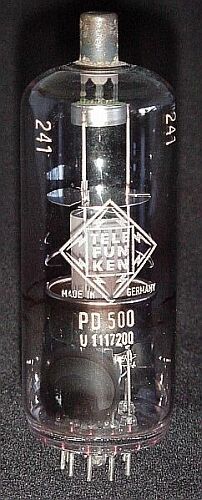 |
This is quite a weired tube. It was used at the
beginning of the colour-TV era to stabilize the high voltage for the colour
picture tubes. It was set as a shunt load in parallel to the picture tube
plate and ground. During dark frames, when the picture tube didn't need
much HV power, this shunt tube was opened a bit more by reducing its negative
grid bias voltage. So it was adding its load to the now missing picture
tube load and did provide in this way a quite constant "overall load" for
the line transformer, who also produced the HV power. In this way, a dangerous
increase of the plate voltage above 27.5 kV could be omitted and it could
be stabilized within 25 - 27 kV. Grid bias swing was about -30 to -3 V.
It is obvious, that this is the most inefficient way to stabilize a
voltage - just "heating away" the excessive power (that prior had to be
generated with expensive high-power tubes such as the PL 519 and PY 500)
really looks very strange today.
|